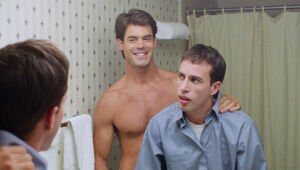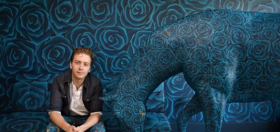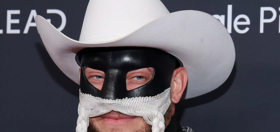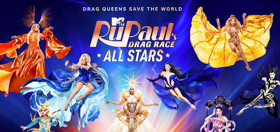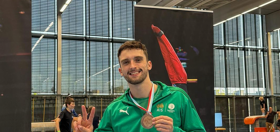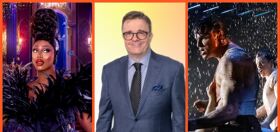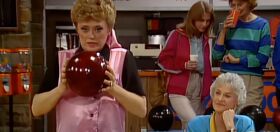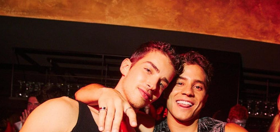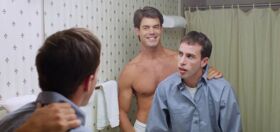Róisín Murphy’s latest album, Take Her Up to Monto, comes just one year after her last, 2015’s Mercury Prize-nominated Hairless Toys. Both sets of songs are markedly more low-key and experimental compared to the Irish singer-songwriter-producers-style innovator’s 2007 international breakthrough album, Overpowered. But while Hairless Toys had a more laidback vibe, Murphy ratchet’s up the tension on Monto. Queerty chatted with Murphy last week about the new album, her distinct visual style, and her continuing obsession with drag ball culture.
You’ve been releasing new music at a pretty steady clip recently—2014’s Italian language EP Mi Senti, last year’s Hairless Toys and now Take Her Up to Monto. Are you making up for lost time?
Actually, those three projects ran out of one another, the first project being Mi Senti. I got the idea to do that because I’m in love with an Italian record producer [Sebastian Properzi], and I just wanted to do it as a love letter to him and with him. We chose the songs together and he produced it with me. But I also involved Eddie Stevens, the guy mainly involved in these two albums. So once I started to work on Mi Senti with him I realized that I could then go on and write music with him for an album. That was just a very prolific time. We set aside five weeks to write and we just wrote an unbelievable amount of stuff. We finished Hairless Toys and we left it there for a while, we went on tour, and then we came back and finished Monto.
How did you divide up those two sets of songs? Were there themes that helped you decide what belonged on Hairless Toys and what belonged on Monto?
I just think we instinctively finished the ones for Hairless Toys — we finished a few more than went on there… I don’t know, we just gravitated toward the songs to finish first. We maybe in some cases were a bit scared of the songs on Monto, because they’re a bit more insane and a bit more of a headache to work out in terms of arrangements and things like that. Maybe I was a bit hesitant because the lyrics on some of these songs are a bit more raw. So in a sense, I think we went for the easier tracks for Hairless Toys. So what you ended up with is Hairless Toys is a much more cohesive, subtle, kind of all gelled together type of statement. And what we got on Monto was the more extreme parts of the personality. It’s a more pointy and complex record.
The mood on Take Her Up to Monto feels a bit more tense than Hairless.
I think that’s probably true, yeah. Lyrically there’s plenty of that, yeah.
How about we take this to the next level?
Our newsletter is like a refreshing cocktail (or mocktail) of LGBTQ+ entertainment and pop culture, served up with a side of eye-candy.
It’s a tense time in the world, in the U.K. and in the U.S.
It is a tense time, yeah. People are really scared.
You’re someone with a very distinct visual style. Do visual aesthetics influence the sound, and the mood of the music you’re making?
Not really, actually. I wait for the imagery. The music is the first thing, always, with me. Not really a visual, but a narrative might inspire a song. I might watch Paris is Burning and then go in the next day and write a song. But I’m definitely not thinking about what the visual of the song will be when I’m making the music.
You’ve talked before about drag and ball culture. What’s the appeal for you?
Well, you know, its just an understanding between us. My kind of performance, and my kind of songwriting as well really, is quite dramatic. I’m trying to kind of push loads of meaning into the performance. I’m trying to get as much across as possible. And I think that’s what I have in kinship there. And all these kind of complex ideas like realness, which has been a big influence on the visual of this campaign—the complexity of that and the irony of it and they dualism of it, it’s what I try to put in the songs, really. I try to do that in my songwriting. There’s an instinctive kind of connection. I don’t k now why.
You keep mentioning instinct. Are you a very instinctual person? Do you just go with your gut all the time?
Yeah, I think all artists are instinctual people. I think that is your currency, honestly.
But you also said you were a little hesitant about some of the songs on Monto. I read that you were afraid “Ten Miles High” didn’t fit in with the rest of the songs. Can you explain what you meant?
Well, Monto wasn’t even a notion at that point. What I’m talking about is that, the way I felt about a song like that was like, is it a bit of a danger zone? It could go into cheese too easily. It had that extremity to it, so we would have been a little bit cautious approaching it. I just mean if you compare songs to people or personalities, extreme personalities are really attractive to me, actually. But there is caution, you know, as you approach. And I think it’s probably the same with some of these songs.
I was reading some of your comments about the “Ten Miles High” video and I love the way you describe the video as almost like realism in drag.
That’s what I’m talkin’ about. Realness, the concept of realness, which is a kind of drag — but the other way. So, I’m sure you know this, but in the pageants they have these different categories for different types of drag. And one of the major types would be realness, and within that they’ll have “executive realness” — you get away with looking like a real business man. Or “college realness,” just looking like a real college kid when you’re not, when you are really flamboyant. It’s a very observational sort of performance. It’s just fascinating, that you can come from this very flamboyant place and adopt mainstream ideas. It’s a very subversive idea.
What were you trying to subvert in that video?
I don’t know if I’m trying to subvert. Going back to realness, that is a very subversive idea, because you’ve got people at the boarders of society kind of playing the role of people at the center. But in my case, there’s a joy in the realness. I’m looking at these buildings and I’m looking at the city and I’m enjoying it. There’s just joy in it.
There’s pageantry even in that, isn’t there?
Well, yes, of course. I was saying to someone else the other day, in the run up to this I was filming lots and lots of things on me phone all around town, going about filming building sites and things like that, and you see them kind of directing big truck in the center of London through quite complex mazes of temporary traffic lights, into secret gates onto building sites. They go out like in a maneuver onto the street. They would direct traffic and pedestrians all in kind of a ballet. You watch it and it’s so well rehearsed. And you see the guys enjoying it. That’s when things all come together in a sort of big network. I observed a lot of things that were really fascinating about real life.
It sounds a bit like orchestrating album, putting together all the parts of a song.
Yeah. It’s also that thing where you feel connected. You see a team working, and even pedestrians playing along with this whole thing. And you see the balance between living in a nice cohesive society, and fucking chaos! You see the line between it.
I’m sure everyone in the States asks you this all the time, but we are patiently awaiting your next show here. How long are you going to keep us waiting?
I’m gonna try and get there in the winter.





